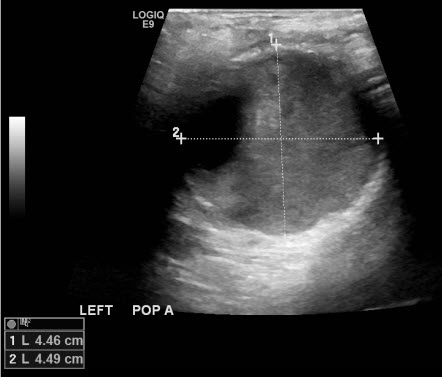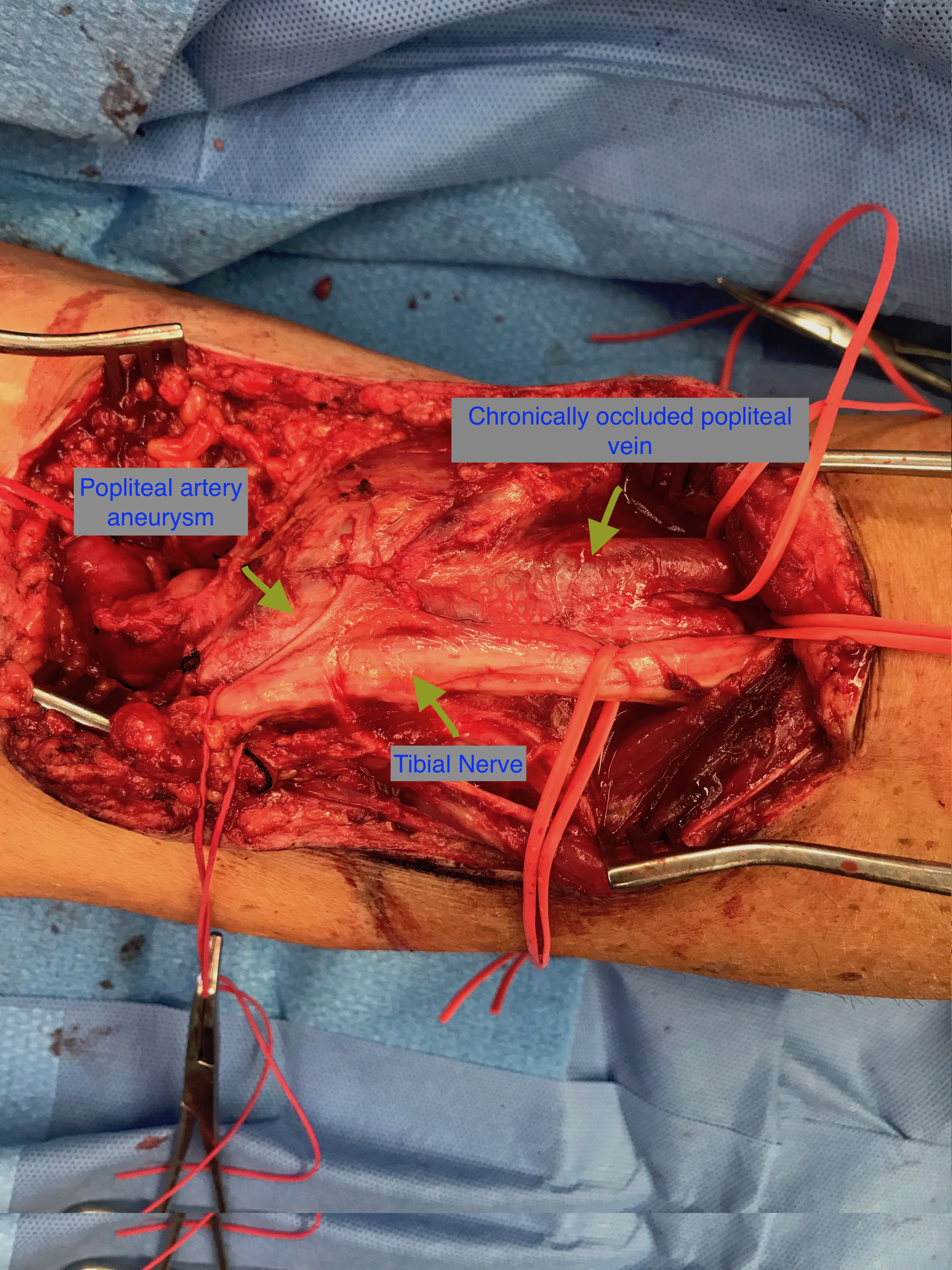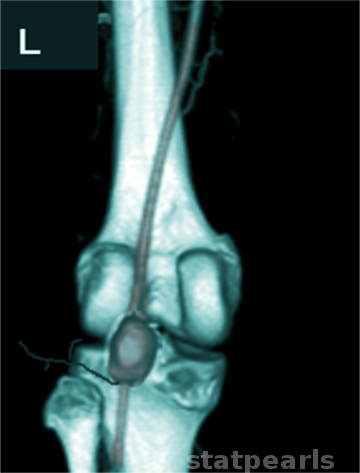[1]
Shiwani H, Baxter P, Taylor E, Bailey MA, Scott DJA. Modelling the growth of popliteal artery aneurysms. The British journal of surgery. 2018 Dec:105(13):1749-1752. doi: 10.1002/bjs.10955. Epub 2018 Aug 23
[PubMed PMID: 30136713]
[2]
Cecenarro RR, Allende JN, Barreras Molinelli L, Antueno FJ, Gramática L. [Popliteal Artery Aneurysms: Literature Review and presentation of case.]. Revista de la Facultad de Ciencias Medicas (Cordoba, Argentina). 2018 Mar 29:75(1):41-45. doi: 10.31053/1853.0605.v75.n1.16097. Epub 2018 Mar 29
[PubMed PMID: 30130484]
Level 3 (low-level) evidence
[3]
Cervin A, Ravn H, Björck M. Ruptured popliteal artery aneurysm. The British journal of surgery. 2018 Dec:105(13):1753-1758. doi: 10.1002/bjs.10953. Epub 2018 Jul 24
[PubMed PMID: 30043540]
[4]
Mikhaylov IP, Lavrenov VN, Isaev GA, Kokov LS, Trofimova EY. [Ruptures of popliteal artery aneurysms]. Khirurgiia. 2018:(4):57-62. doi: 10.17116/hirurgia2018457-62. Epub
[PubMed PMID: 29697685]
[5]
Fioranelli A, Carpentieri EA, Wolosker N, Castelli V Jr, Caffaro RA. Rupture of Thrombosed Popliteal Aneurysm: A Case Report. Annals of vascular surgery. 2018 Aug:51():324.e7-324.e10. doi: 10.1016/j.avsg.2017.12.024. Epub 2018 Mar 5
[PubMed PMID: 29518513]
Level 3 (low-level) evidence
[6]
Golchehr B, Zeebregts CJ, Reijnen MMPJ, Tielliu IFJ. Long-term outcome of endovascular popliteal artery aneurysm repair. Journal of vascular surgery. 2018 Jun:67(6):1797-1804. doi: 10.1016/j.jvs.2017.09.040. Epub 2017 Dec 29
[PubMed PMID: 29291906]
[7]
Cousins RS, Dexter DJ, Ahanchi SS, Cain BC, Powell OM, Ongstad SB, Parikh NM, Panneton JM. Determining patient risk factors associated with accelerated growth of popliteal artery aneurysms. Journal of vascular surgery. 2018 Mar:67(3):838-847. doi: 10.1016/j.jvs.2017.07.117. Epub 2017 Dec 22
[PubMed PMID: 29276109]
[8]
Ravn H, Pansell-Fawcett K, Björck M. Popliteal Artery Aneurysm in Women. European journal of vascular and endovascular surgery : the official journal of the European Society for Vascular Surgery. 2017 Dec:54(6):738-743. doi: 10.1016/j.ejvs.2017.10.001. Epub 2017 Nov 7
[PubMed PMID: 29126647]
[9]
Kim SM, Jung IM. Successful Endovascular Treatment of a Ruptured Popliteal Artery Aneurysm in a Patient with Behcet Disease. Annals of vascular surgery. 2018 Nov:53():274.e1-274.e5. doi: 10.1016/j.avsg.2018.05.076. Epub 2018 Aug 6
[PubMed PMID: 30092437]
[10]
Ucci A, Curci R, Azzarone M, Bianchini Massoni C, Bozzani A, Marcato C, Marone EM, Perini P, Tecchio T, Freyrie A, Argenteri A. Early and mid-term results in the endovascular treatment of popliteal aneurysms with the multilayer flow modulator. Vascular. 2018 Oct:26(5):556-563. doi: 10.1177/1708538118771258. Epub 2018 Apr 17
[PubMed PMID: 29665749]
[11]
Sousa RS, Oliveira-Pinto J, Mansilha A. Endovascular versus open repair for popliteal aneurysm: a review on limb salvage and reintervention rates. International angiology : a journal of the International Union of Angiology. 2020 Oct:39(5):381-389. doi: 10.23736/S0392-9590.20.04387-4. Epub 2020 Apr 29
[PubMed PMID: 32348102]
[12]
Tian Y, Yuan B, Huang Z, Zhang N. A Comparison of Endovascular Versus Open Repair of Popliteal Artery Aneurysms: An Updated Meta-Analysis. Vascular and endovascular surgery. 2020 May:54(4):355-361. doi: 10.1177/1538574420908091. Epub 2020 Mar 3
[PubMed PMID: 32122277]
Level 1 (high-level) evidence
[13]
Farber A, Angle N, Avgerinos E, Dubois L, Eslami M, Geraghty P, Haurani M, Jim J, Ketteler E, Pulli R, Siracuse JJ, Murad MH. The Society for Vascular Surgery clinical practice guidelines on popliteal artery aneurysms. Journal of vascular surgery. 2022 Jan:75(1S):109S-120S. doi: 10.1016/j.jvs.2021.04.040. Epub 2021 May 20
[PubMed PMID: 34023430]
Level 1 (high-level) evidence
[14]
Peng KX, Davila VJ, Fowl RJ. Successful repair of a popliteal aneurysm with saphenous vein graft in a patient with Marfan syndrome. Journal of vascular surgery cases and innovative techniques. 2019 Dec:5(4):393-395. doi: 10.1016/j.jvscit.2018.08.008. Epub 2019 Sep 17
[PubMed PMID: 31660457]
Level 3 (low-level) evidence
[15]
Wang S, Kernodle A, Hicks CW, Black JH 3rd. Endovascular repair of tortuous recurrent femoral-popliteal aneurysm in a patient with Loeys-Dietz syndrome. Journal of vascular surgery cases and innovative techniques. 2018 Jun:4(2):156-159. doi: 10.1016/j.jvscit.2018.03.001. Epub 2018 Apr 30
[PubMed PMID: 29942909]
Level 3 (low-level) evidence
[16]
Waterman AL, Feezor RJ, Lee WA, Hess PJ, Beaver TM, Martin TD, Huber TS, Beck AW. Endovascular treatment of acute and chronic aortic pathology in patients with Marfan syndrome. Journal of vascular surgery. 2012 May:55(5):1234-40; disucssion 1240-1. doi: 10.1016/j.jvs.2011.11.089. Epub 2012 Apr 1
[PubMed PMID: 22465552]
[17]
Kaufman RL. Popliteal aneurysm as a cause of leg pain in a geriatric patient. Journal of manipulative and physiological therapeutics. 2004 Jul-Aug:27(6):e9
[PubMed PMID: 15319769]
[18]
Fargion A, Masciello F, Pratesi G, Giacomelli E, Dorigo W, Pratesi C. Endovascular Treatment with Primary Stenting of Acutely Thrombosed Popliteal Artery Aneurysms. Annals of vascular surgery. 2017 Oct:44():421.e5-421.e8. doi: 10.1016/j.avsg.2017.04.027. Epub 2017 May 5
[PubMed PMID: 28483627]
[19]
Lee TL, Bokovoy J. Understanding discharge instructions after vascular surgery: an observational study. Journal of vascular nursing : official publication of the Society for Peripheral Vascular Nursing. 2005 Mar:23(1):25-9
[PubMed PMID: 15741962]
Level 2 (mid-level) evidence
[20]
Salzler GG, Long B, Avgerinos ED, Chaer RA, Leers S, Hager E, Makaroun MS, Eslami MH. Contemporary Results of Surgical Management of Peripheral Mycotic Aneurysms. Annals of vascular surgery. 2018 Nov:53():86-91. doi: 10.1016/j.avsg.2018.04.019. Epub 2018 Jun 8
[PubMed PMID: 29886217]
[21]
Wrede A, Wiberg F, Acosta S. Increasing the Elective Endovascular to Open Repair Ratio of Popliteal Artery Aneurysm. Vascular and endovascular surgery. 2018 Feb:52(2):115-123. doi: 10.1177/1538574417742762. Epub 2017 Dec 4
[PubMed PMID: 29202650]
[22]
Leake AE, Segal MA, Chaer RA, Eslami MH, Al-Khoury G, Makaroun MS, Avgerinos ED. Meta-analysis of open and endovascular repair of popliteal artery aneurysms. Journal of vascular surgery. 2017 Jan:65(1):246-256.e2. doi: 10.1016/j.jvs.2016.09.029. Epub
[PubMed PMID: 28010863]
Level 1 (high-level) evidence



